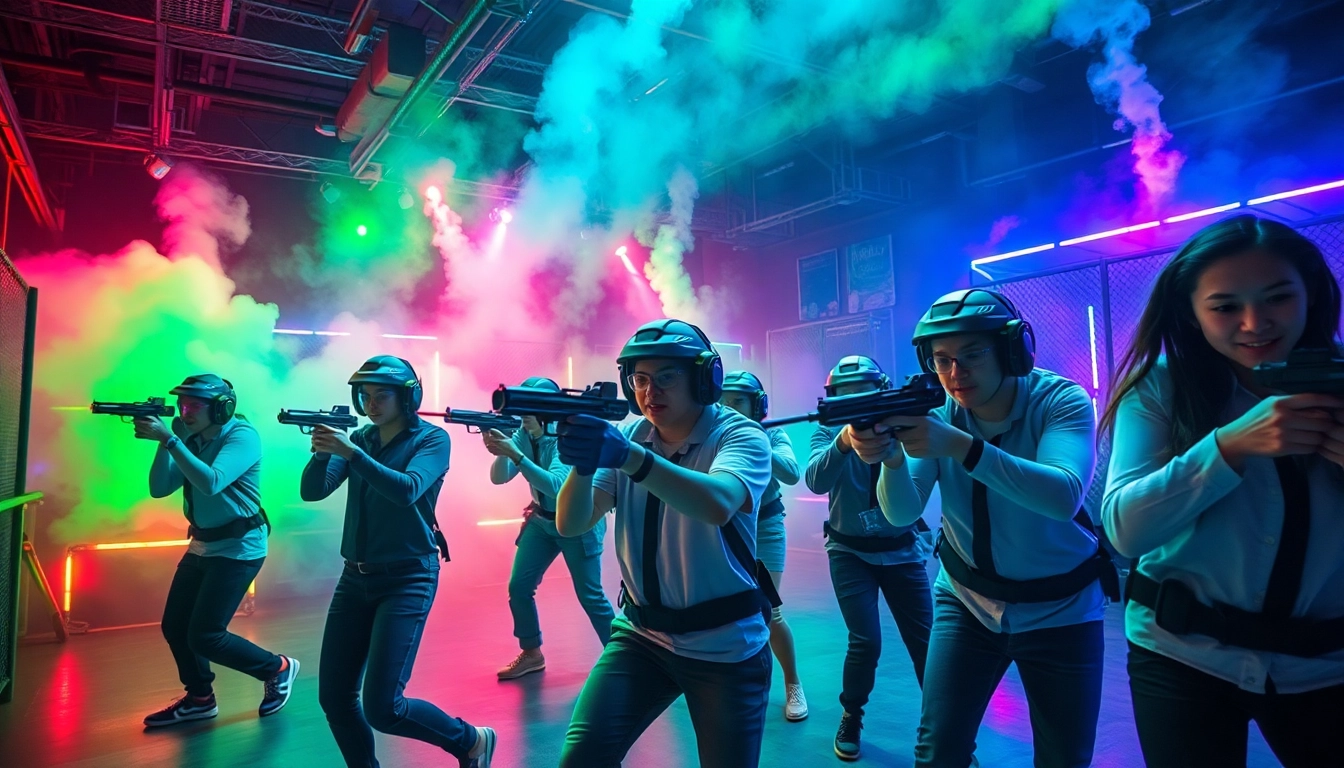Understanding Laser Tag
The Basics of Laser Tag
Laser tag is an exhilarating and competitive recreational activity that enables players to engage in team-based combat simulations using infrared-emitting light guns. The objective is simple yet thrilling: tag opponents with beams of light while avoiding being tagged. Each player typically wears a vest equipped with sensors that register hits, and scores are tallied based on accuracy and gameplay strategy. The innovation behind laser tag lies in its ability to blend physical activity with strategic gameplay, creating an enticing experience for individuals and groups alike.
The gameplay environment can vary significantly, from indoor arenas filled with obstacles and themed decorations to outdoor arenas that leverage natural landscapes. Technology plays a pivotal role; modern laser tag systems often feature advanced scoring systems, special effects like fog and lighting, and intricate mission-based gameplay scenarios that further enhance player engagement. In exploring destinations for laser tag, you might find unique offerings suited to both casual players and competitive enthusiasts.
History and Evolution of Laser Tag
The concept of laser tag traces back to the late 1970s, inspired by the invention of an early laser technology. Pioneers established the first commercial laser tag game in 1984 at a venue in Texas, which quickly captured the imaginations of players worldwide. Over the following decades, advancements in technology have propelled laser tag into a mainstream entertainment option, with improved equipment, sophisticated scoring systems, and immersive environments designed for enhanced gameplay experience.
As laser tag gained popularity, its evolution included a variety of game styles and formats. From simple team battles to elaborate mission-based games, players can experience thematic stories intertwined with competition. The evolution also reflects societal changes, with benefits extending beyond mere entertainment, encompassing social experiences, fitness opportunities, and youth engagement in recreational sports.
The Mechanics of Laser Tag Gameplay
Laser tag gameplay is governed by a set of rules that vary depending on the venue and game format, yet certain fundamental mechanics remain consistent. Players can choose between different modes—such as free-for-all, team battles, or objective-based missions—that dictate the dynamics of play. Each participant is equipped with a laser tag gun and vest, which provide real-time feedback on hits and remaining health points.
During the game, communication and strategy become paramount. Players must coordinate their movements and tactics to outsmart opponents. Tactics may include employing stealth tactics, using cover effectively, and adopting strategies that maximize the use of the arena’s landscape, such as hiding behind obstacles or rushing for advantageous positions. Additionally, understanding the specific gameplay mechanics, like scoring systems and power-ups, can impact individual and team performance.
Choosing the Right Laser Tag Venue
Factors to Consider When Selecting a Venue
Selecting the ideal laser tag venue can significantly enhance your experience. Key factors to consider include the venue size, layout, and design. Larger arenas often provide more complex environments, allowing players to engage in diverse combat scenarios, while smaller venues may favor fast-paced interactions. Additionally, the quality and maintenance of equipment used can influence gameplay; ensure that the venue utilizes up-to-date technology that offers accurate scoring and consistent performance.
Another crucial aspect to consider is safety protocols. A reputable venue will uphold high safety standards, including regular equipment checks and clear operational guidelines. Finally, assess the availability of features such as varied game modes, themed arenas, and additional amenities like food and beverage services, which can enhance the overall enjoyment of your visit.
Types of Laser Tag Arenas
Laser tag arenas come in various forms, each offering a unique experience tailored to different preferences. Indoor venues commonly employ elaborate themes, facilitating immersive experiences enriched with enhanced lighting, sound effects, and obstacles. These indoor setups allow for creative gameplay and sustained enjoyment, regardless of the weather outside.
Outdoor arenas, on the other hand, provide a different flavor to the experience. Often designed to blend with natural terrains, outdoor venues may feature fortresses and woodlands that users can navigate. This setting accommodates larger player counts and introduces varied gameplay dynamics, enabling players to utilize their environment creatively. Hybrid arenas combining indoor and outdoor elements also exist, catering to players seeking the best of both worlds.
Popularity and Accessibility of Laser Tag Locations
The popularity of laser tag continues to grow, making it a sought-after entertainment option for various events, including birthday parties, team-building exercises, and corporate outings. Various locations ensure that more individuals can access exciting experiences, from dedicated amusement centers to mobile laser tag operators.
As demand rises, many venues offer packages tailored for different group sizes and purposes, promoting greater accessibility. Social media and word-of-mouth also serve as powerful tools that enhance visibility, driving more players to engage in the experience, thus allowing for continuous growth within the community.
Strategies for Success in Laser Tag
Team Coordination and Communication
Collaboration is a key component of success in laser tag, particularly during team-based gameplay. Effective communication ensures that all team members are aware of movements, strategies, and objectives, thereby minimizing confusion and enhancing operational efficiency. Establishing simple signals or codes can aid in relaying information quickly during the heat of battle.
Forming a cohesive strategy also encompasses identifying each player’s strengths and weaknesses. By distributing roles—such as scouts, defenders, or snipers—teams can play to the unique abilities of each member, leading to more effective engagement during matches.
Effective Use of Cover and Movement
Mastering the arena layout and utilizing cover effectively can greatly enhance players’ survival and success rates. Knowing where to find shelters—be it walls, obstacles, or even structures—allows players to take strategic positions. It is critical to remain aware of positioning while maintaining mobility; players should move unpredictably to avoid being tagged while transitioning from one cover point to another.
Engaging in tactical movement can change the game’s momentum. Use techniques such as flanking, where players move around the opponent’s defenses, or pincer movements, where teammates coordinate attacks from multiple angles to overwhelm the opposition. This creates opportunities for effective tagging while keeping players out of harm’s way.
Game-Specific Tactics for Competitive Play
Each laser tag game variant has unique strategies suited to its rules and objectives. Familiarizing yourself with the specific game rules can provide a competitive edge; for example, understanding when to hold back and conserve energy versus when to take risks for scoring plays can differentiate skilled players from novices.
In objective-specific games, players should prioritize missions and goals over eliminations. Assessing the game requirements and adapting tactics accordingly will ensure that teams remain focused on achieving victory through strategic planning. Ultimately, flexibility in strategic thinking can be the deciding factor between triumph and defeat.
Planning a Laser Tag Event
Organizing the Perfect Laser Tag Party
Planning a successful laser tag event requires careful consideration of logistics, guest management, and activities to ensure a memorable experience. Begin by selecting a suitable venue that accommodates your group size, and check their offerings for party packages or group discounts.
Guest coordination is essential; ensure all participants are aware of the event specifics, including date, time, and any themed elements involved. Additionally, consider incorporating food and beverage options to sustain energy levels and foster a social atmosphere post-game.
Incorporating Themes and Special Features
To make your laser tag event truly stand out, consider incorporating themes that resonate with your group’s interests. Whether aligning with popular culture references, holiday themes, or specific color codes, a well-conceived theme can elevate the event and spur excitement among attendees. Adding unique features such as customized scoring systems, themed decorations, or soundtracks can further enhance the immersive experience.
Incorporating challenges, prizes, or team competitions can motivate players and introduce an element of friendly rivalry, enriching the overall atmosphere of the event.
Budgeting and Pricing Considerations
When planning a laser tag event, budgeting accurately is crucial for a seamless experience. Analyze anticipated costs, which may include venue rental, equipment fees, food and drink expenses, and any additional entertainment or thematic elements. Many venues offer online pricing calculators or estimate tools to help you calculate total costs efficiently.
Also, factor in potential discounts for larger groups, which may help you stretch your budget further. Establishing a clear budget from the outset will help guide your planning decisions and prevent overspending while ensuring an enjoyable event.
The Benefits of Playing Laser Tag
Physical and Mental Health Advantages
Participating in laser tag provides an exciting way to engage in physical activity, combining running, hiding, and strategizing, which promotes cardiovascular health. The element of competition heightens the engagement factor, ensuring that participants remain motivated and active throughout the game.
Additionally, laser tag challenges the mind as players strategize their moves and adapt to dynamic scenarios. This blend of physical exertion and mental stimulation contributes to overall well-being and can enhance cognitive functions like decision-making, teamwork, and problem-solving.
Building Teamwork and Social Skills
Laser tag inherently promotes social interaction and teamwork, encouraging participants to collaborate towards a common goal. Team-based gameplay fosters essential communication skills, helping individuals learn to convey thoughts in high-pressure environments succinctly.
Beyond the game, laser tag serves as an effective tool for team-building, often utilized by organizations to strengthen workplace relationships. Groups will work together to accomplish tasks, reinforcing bonds among colleagues and enhancing mutual respect and collaboration.
Engagement and Fun for All Ages
One of the greatest appeals of laser tag is its inclusivity—players from diverse age groups can engage in thrilling gameplay together. Whether you’re a child, a teenager, or an adult, laser tag caters to everyone and encourages participants to share exciting experiences, creating lasting memories.
The versatility of laser tag ensures that it can be an ideal option for various occasions, be it family outings, birthday parties, or corporate events. The capacity for customization regarding themes and formats means groups can tailor their experiences to suit their interests, energizing participants and yielding unforgettable fun.



